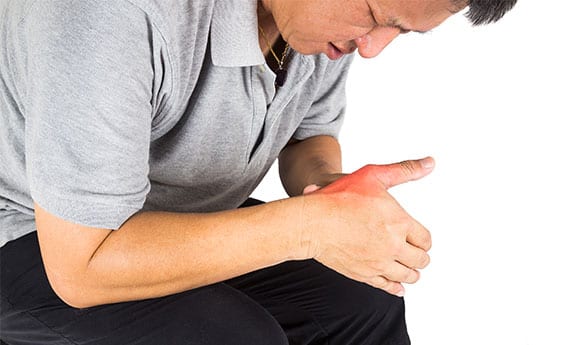
LA Orthopedic Group can help you to relieve Gout flare-ups.
Gout is a form of arthritis that is characterized by sudden attacks of joint pain. It is most common in men over the age of 40 and post-menopausal women. The following are associated with an increased risk of developing gout:
- A diet rich in purine
- Some medical conditions and medications
- Family history
- Obesity
CONTACT US TODAY
Causes of Gout
Uric acid is produced when the body metabolizes purine, which is found in steak, seafood, and organ meats. Drinks sweetened with fructose and alcoholic beverages can also increase uric acid levels. Normally, uric acid is excreted through the process of urination. If the body produces too much uric acid or the kidneys are unable to excrete it efficiently, it can build up and form urate crystals that collect in the joints and surrounding tissues to cause intense pain and swelling.
Symptoms of Gout
Most people with gout experience episodic flares during which the affected joints become swollen, red, warm to the touch, and extremely tender. Although gout can occur in any joint, it most often occurs in the big toe. A gout attack can develop in a matter of hours, and the pain can be so intense that wearing a shoe can be unbearable. In many cases, the symptoms resolve on their own within a couple of weeks. Recurrent attacks typically need to be managed with medications to prevent permanent joint damage. In severe cases, uric acid deposits in the tissue can develop into nodules known as tophi. These nodules may be unsightly, but they are generally painless.


Diagnosing Gout
The characteristic swelling, redness, and tenderness of the big toe are often sufficient to diagnose gout. The doctor may order a blood test to check the level of uric acid in the blood and to assess kidney function. It is possible, however, to have a high uric acid level without developing gout symptoms or to have symptoms with a normal uric acid level. If a more definitive diagnosis is needed, the doctor may perform an arthrocentesis in which a needle is used to draw fluid from the affected joint. The fluid is then analyzed for the presence of urate crystals.
Treatment of Gout
Although dietary changes can help reduce the severity and frequency of gout attacks, some patients may need medications to manage their symptoms. Pain medications, such as nonsteroidal anti-inflammatory drugs, corticosteroids, and colchicine can help reduce the inflammation and discomfort of an acute gout attack. Xanthine oxidase inhibitors, such as febuxostat and allopurinol, can help the body produce less uric acid. The medication probenecid can help increase the amount of uric acid excreted through urination.




